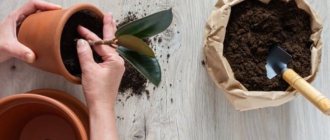October is golden autumn, leafy and wedding.
In October, the last plants that could still remain in the garden or on the balcony (such as aucuba, laurel, ligustrum, boxwood) are brought indoors. At this time, many indoor plants enter a state of winter dormancy. Therefore, they need to be watered much less frequently and not fed with anything until spring. In the middle or end of October, due to weather conditions, when the temperature remains stable at -5-8 C, they begin to cover the roses for the winter with spruce branches. If there are prerequisites for the onset of early severe frosts with a small amount of snow, then you can fill the central part of the rose bush with dry humus and compost, and you need to protect them from moisture, covering them so that air circulation is ensured under the cover, otherwise the roses may dry out.
Helpful advice. How to clean a clay pot from white limescale or stains? - Rub the pot with raw potatoes, and then rinse everything off in water with a stiff brush.
ATTENTION! Our gardener's lunar calendar is kept according to Moscow time . (The calendar can be used throughout Russia, taking into account the difference between Moscow and local time *
)
Moon calendar |
Lunar calendar for replanting indoor plants for January 2022
It is worth replanting on the young Moon:
- in the sign of Pisces (January 20)
- in Taurus (January 25, 26)
Do not plan the work of propagating and transferring flowers into new pots for January if there is no need (updating the substrate for new settlers, urgent replanting when the plant is in a depressed state).
January is the month of plant rest, they gain strength before spring, vital processes slow down
Favorable days for planting indoor flowers
Planting is rightly considered one of the most important procedures in caring for an apartment garden. To make this first step go smoothly, it is recommended to find a calendar for replanting indoor plants for 2022. It contains the basic numbers suitable for sowing and planting seedlings and seeds, and transferring adults to new containers.
Maximum efficiency for the gardener is ensured by following all the recommendations of the specialists who draw up the sowing calendar.
So, in 2022 it is worth taking into account this division of months with the corresponding care recommendations.
When planting indoor plants, guidance from the lunar calendar significantly increases the likelihood of acclimatization and increased growth as quickly as possible.
In addition, special attention should be paid to other procedures related to planting, moistening and pruning.
The lunar calendar is an important list of dates, with precise indications of the most effective activities for all ten days of the month.
Flower growth processes are influenced not only by a well-chosen container, timely watering and sufficient lighting, but also by the timeliness of these measures. It is precisely in order to reduce the likelihood of error to a minimum that the annual lunar calendar is compiled.
Watch an interesting video about replanting indoor plants and how to determine favorable days for this event:
In order for indoor flowers to delight with their beauty, they must be properly cared for, which means not only watering and fertilizing, but also replanting the plants. In this article we will talk about how flowers are transplanted according to the lunar calendar 2018.
Any manipulation for house plants is stressful. To reduce it, you must follow the recommendations of the lunar calendar. Let's start with favorable days for transplantation:
- January – 18–30;
- February – 17–28;
- March – 18–30;
- April – 17–29;
- May – 16–28;
- June – 14–27;
- July – 14–26;
- August – 12–25;
- September – 10–24;
- October – 10–23;
- November – 8–22;
- December – 8–21.
Winter is a dormant season, when there is no need to replant houseplants at all.
But if such a need arises, then do it on the days indicated in the lunar calendar. On favorable dates, the juice is at the top, so the roots are less sensitive and are able to withstand all manipulations.
Lunar calendar for replanting indoor plants for June 2022
It is recommended to replant when the Moon:
- in Cancer (June 15, 16)
- in Scorpio (June 23, 24)
At the beginning of summer, it is good to replant coniferous indoor crops, as well as azaleas and camellias. These plants are difficult to transplant, so we carry out the work carefully. A reliable method is transshipment; the roots are little injured and take root quickly.
We remove the plant from direct sunlight into the shade for better adaptation.
Unfavorable period
The lunar calendar for flower transplantation (2018) also includes unfavorable and even prohibited days for planting:
- January: unfavorable – 3–17 (prohibited – 2, 31);
- February: 1–14, 16 (15);
- March: 3–17 (2, 31);
- April: 1–16 (30);
- May: 1–15, 30, 31 (29);
- June: 1–13, 29, 30 (28);
- July: 1–12, 28–31 (13, 27);
- August: 1–10, 27–31 (11, 26);
- September: 1–9, 26–30 (25);
- October: 1–9, 25–31 (24);
- November: 1–7, 24–30 (23);
- December: 1–7, 23–31 (22).
If manipulations are carried out on dates when it is undesirable to replant flowers according to the lunar calendar 2018, the green planting may suffer for a long time or may not even take root. The fact is that on unfavorable days, the sap of the plant strongly flows to the roots, which is why the root system becomes too sensitive.
Damage to the roots, which often happens during the transplanting process, can lead to the death of the plant.
Is it possible to replant indoor flowers in October?
Sometimes, when passing by someone else’s pot with a treasured flower, your hands reach out to pinch off a small shoot. But what to do if October 2022 is not the best time for propagating and replanting plants?
Again, it’s worth turning to the characteristics of your favorite flower. For example, geranium is easily propagated by semi-lignified, green cuttings in August - early October... Dichorysandra, oplysmenus, netcreasia, syngonium nofolia or tradescantia will take root no less quickly in October. By the way, the list of plants is far from exhaustive. Maybe the list will be replenished with a new species?
The problem with replanting (transshipment) of your favorite flowers during this period is no less relevant. What to do if the optimal time for replacing the soil is missed, and the plant has grown to enormous sizes? Of course, in some cases it is advisable to postpone the event until early spring. However, for some indoor plants, October 2018 is quite suitable for replanting.
For example, in mid-autumn you can safely refresh the soil of almost all varieties of azaleas; calla lilies (calla lilies); amaryllis; ahimenes; spathiphyllum; petunia; dracaena; Tradescantia; chlorophytum; asparagus and many other plants that were planted in the garden for the summer.
Important! Only healthy flowers that have the strength to recover from the stress of the last sunny days are allowed to be replanted (transferred) in October.
The heating season begins in mid-October, which means severe tests await your pets in the form of dry air and temperature changes. Study the characteristics of your plant in advance to be able to promptly take care of air humidification or choose the right place for the flower to overwinter.
So, caring for indoor plants in October 2022 can be reduced to 4 main actions:
- moderate watering;
- reducing portions or refusing to feed;
- work to humidify the air in the room and maintain optimal temperature;
- following the advice of the lunar calendar.
We wish your home to be filled with flowers, and a luxurious, bright greenhouse to lift your spirits and warm your soul all year round.
Did you like the material? It's easy to say thank you! We would be very grateful if you share this article on social networks:
On the growing, young Moon, you can take time to plant or simply transplant into a new container. This is due to the fact that during this period, representatives of the indoor garden receive a new influx of energy when transplanting. This has a beneficial effect on growth processes and their activation. On the waning Moon, there comes a period that is unsuitable for any active actions in relation to flowers, since during this phase the flow of energy stops at the root system. Thus, transplantation procedures can harm the root, thus disrupting energy circulation processes and even lead to death. Second and fourth phase Optimal time for pruning and replanting plants. Flowers calmly tolerate all manipulations with minimal damage to themselves if the procedures are carried out correctly.Thus, the presence of the earth’s satellite in a specific sign is reflected in the state of green pets:
- Water signs of the zodiac are known for their fertility. Sowing carried out on the days when the Moon enters the symbols of the water element or Taurus, Libra, Leo will be effective and will lead to the activation of the first shoots and their active growth;
- The symbols of the elements of air (Aquarius and Gemini) and earth (Capricorn and Virgo) are characterized by insignificant fertility indicators. This is not the most optimal time for planting, but with proper care, seedlings will not keep you waiting;
- Dry signs of the earth elements (Aries and Sagittarius) are not favorable for planting seeds and seedlings. On dry signs, it is better not to undertake any activities involving replanting; the flowers simply do not have enough energy reserves for subsequent life activity and they may dry out.
Before planting, it is important to take into account what phase the Moon is in and the astrological symbol in which it resides. This can be determined by astrological calendars, which are compiled and published annually.
Let's learn more about the moon's influence on the life of indoor plants:
Lunar calendar for replanting indoor plants for March 2022
We transplant to the growing Moon:
- in Taurus (March 21)
- in Cancer (March 25,26)
The first month of spring is perfect for transplanting and propagating flowers on your windowsill:
- If the plant is young, it is advisable to replant it every year; its root mass is forming and growing rapidly, and if it is mature, once every few years is enough.
- For small crops, pots should not be purchased for growth and should not exceed a diameter of more than two to three cm.
- Large giant plants are replanted very rarely, once every 8-12 years.
How to properly form a crown?
The main task that the gardener sets when pruning is to create a foundation for the formation of a beautiful crown in the future for a green pet. Some plant owners do this on the principle that the appearance of the window sill occupant pleases them here and now, without paying attention to the direction of the young buds. As a result, within a month, the decorative qualities of the inhabitant of the pot or flowerpot are completely lost.
Important! Proper pruning provides a long-term effect of the procedure.
Branches that grow inside the crown or in a direction different from the direction of growth of other shoots can make a bush unsightly. They need to be cut correctly.
Also, some of the shoots growing parallel to each other must be removed, as they thicken the flower.
What is needed for manipulation?
Different pruning options will require different available and specialized tools. If there is a need for:
- When performing delicate pruning , you will need a surgical scalpel or safety razor blade;
- removing young shoots , then prepare a small kitchen knife or its garden equivalent;
- When removing faded buds, overly long shoots or woody shoots , a small pruner for houseplants is best suited.
All tools must be clean, sharp, disinfected and easy to use.
Do not use regular office scissors or a cutting tool , because their wide cutting edges compress the flower tissue, creating torn cuts that take a very long time to heal.
Execution technique
In order for the pruning procedure to be successful, and for the health of the plant and the grower not to be damaged, it is necessary to follow a simple step-by-step technique. Regardless of the type of manipulation, you should:
- Refuse to combine transplanting and pruning activities, maintaining a gap of 14 days between them.
- Study the information on pruning the specific species that will undergo the procedure, because some plants require frequent pruning, while others cannot even tolerate pinching.
- Examine the flower, assessing its condition. In this case, it is necessary to identify unproductive shoots, determine the degree of material removal and select the shape of the future crown.
- Select tools suitable for solving the task, wash them and your hands, and disinfect them.
- Wear gloves if you have to trim poisonous plant species.
- Apply the cuts correctly, cutting the sprouts at an angle above the bud.
- Pay special attention to the location of the kidneys.
- Make cuts smooth.
- Treat injured areas with disinfectants.
- Take breaks while assessing the results of the procedure so as not to overdo it and remove too much from the flower.
How to treat the cut after the procedure?
There are a large variety of products suitable for processing a cut on the trunk of a house plant.
The best results in terms of disinfection, stopping the flow of juice and healing were shown by:
- Activated carbon;
- sulfur powder;
- wood ash powder;
- brilliant green;
- potassium permanganate (potassium permanganate);
- clay mash;
- putty based on linseed oil;
- garden var;
- “RanNet” paste;
- biobalm RobinGreen.











